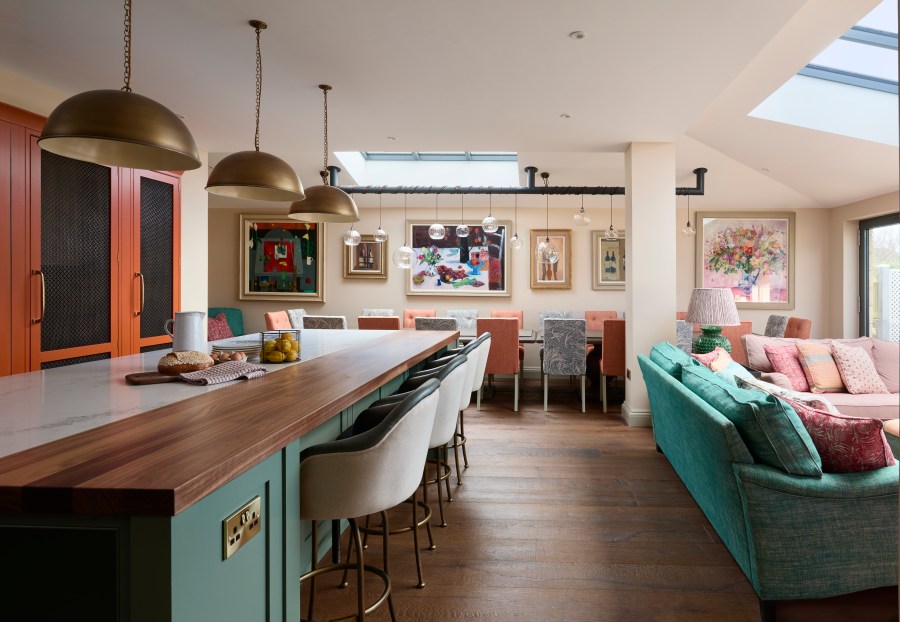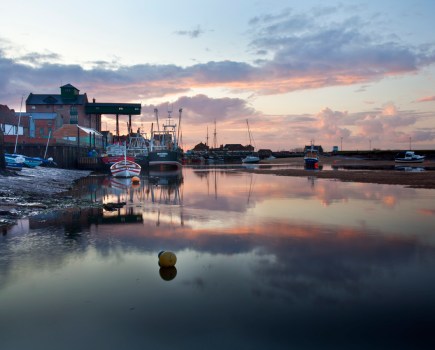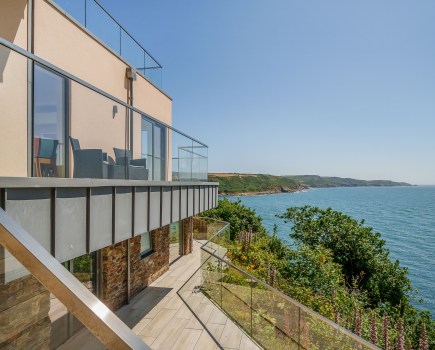Creating a sanctuary with the perfect coastal interiors takes time, effort and an expert eye for detail. Chrissy Harris talks to some top interior designers about how it’s done… and there’s not a bit of driftwood in sight.
Cutting a rug
It often starts with a rug. “You can get such beautiful ones that can inspire the rest of the room,’ says coastal interiors designer Caroline Palk. “In a snug sitting room, the right pattern can look like the water coming in on a beach, highlighting the contours in the sand…”
Sigh. How lovely to have the seaside at your feet with all the comforts of home. Making sure a room has the right patterns and textures is part of an intricate process for Caroline and her team at Ashton House Design in Devon. They have worked on some incredible coastal houses, from contemporary builds to period properties in need of a transformation.
For every project, the mantra is the same. “How do I pay homage to this stunning location?” says Caroline. “You’re looking at the all the materials, the finishes, the colour palettes,” she adds. “You’ve got this fab view outside but then you want to look back into the interior and match that same feeling, especially when it’s dark outside or lashing with rain.
“Essentially, you’ve got to do something inside that stands up to the view outside.”
Caroline says getting this right is a delicate balancing act between embracing the location, but not the theme.
“It’s not about being pastiche or walking into a twee coastal property,” she says. “We know we’re by the sea but let’s not put any driftwood or pebbles around.”
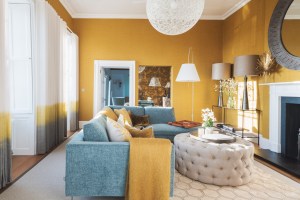
Instead, little nods, such as lamps reflecting the blues and greens of sea glass bring a natural warmth, rather than nautical glitz. A terrazzo tile with strong blues, taupes and ivories can make a subtle seaside statement on floors or walls. And window dressing is very important.
“We do lots of lovely textural voiles and sheers,” says Caroline, talking about the types of delicate, billowing curtains that she likes to use to soften a big space. “It can be daunting working out how to fill up this big expanse of glass because you’re talking a lot of meterage. But with a textural voile, you can get a wide width and you don’t have a join in the fabric. These panels of curtains essentially edit the view. You get the sun shining in through them and the reflections from the water.”
Caroline loves bringing her ideas, experience and contacts to new projects. She’s just finished working on a quayside cottage in the much sought after town of Salcombe in south Devon. Before that, she was asked to work on a country house in Tintagel, Cornwall with panoramic sea views.
“Oh, I just love these coastal projects,” says Caroline. “I just think how incredible it must be to live with that aspect, to look out and see boats and to have all of that peace and quiet,” she adds, before mentioning one rather crucial design requirement. “I make sure there is a prime seat, in a prime spot,” she says. “It’s usually the best, most comfortable chair – and preferably one that swivels.
“That means you can sit and look at the view and then turn back to look at the view inside.” The best of both worlds. ashtonhousedesign.co.uk
Get your home ready for spring with coastal spring interiors
Technicolour dream
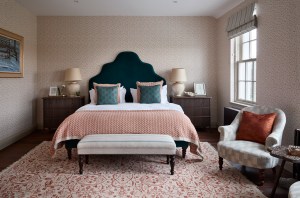
For Tess MacGeachy, life can sometimes be way too grey. The London-based interior designer has used clashing colours, patterns, textures to bring warmth and magic to a coastal home in the East Neuk area of Fife. And not just anyone’s home. The extended Georgian semi-detached property belongs to her parents who bought it three years ago as an overspill house for friends and family to enjoy.
But the ‘untouched’ building needed a rethink. Tess worked with an architect to extend the back of the house to make the most of the ‘incredible’ sea views, adding an open-plan kitchen-living-dining area with utility and butler’s pantry.
With the full benefit of the location realised, it was up to Tess to fill in the blank canvas.
“I had full liberty to do what I wanted to do,” says Tess, mindful of going down any obvious design routes. “Coastal homes are so not about cliches and the nautical theme didn’t really speak to this house,” she adds. “I could have just seen that view and gone quite empty and stark, allowing it to be the centre of attention. But I wanted to bring the colours in. I wanted to bring those greens and blues inside.”
Tess says it pays to experiment with wallpaper, pattern and different shades to help create a ‘cocooning ambience’.
“Really dark colours can make a space feel snug,” she says. “And I love colours that feel as though they’ve got a bit of dirt in them, like browns and earthy tones. They feel a bit older, a bit worn in.”
Antique searching and the right vintage finds have helped the house feel like a lived in and well-loved family home, which just so happens to be on the coast.
“I’m in no way a minimalist and I’m not saying you need loads of clutter, but homes need to be happy places, wherever they are,” says Tess. “You want a place filled with memories that’s going to be somewhere to chill and relax.” amberyard.co.uk
Well impressive
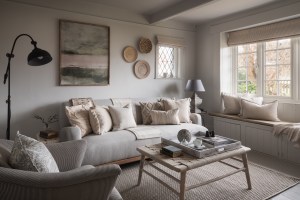
When Claire Georghiades bought a comforting but slightly tired thatched cottage on the West Sussex coast, she knew she had to play to her strengths. The chartered accountant got together a budget, a spreadsheet and contacted interiors designer Paul Hervey of PHI Concepts.
“I have no clue about interiors,” says Claire, laughing. “I just thought, how on earth am I going to tackle it?” she adds, describing the outdated colour schemes (such as pink walls and light green skirting boards) that initially greeted her inside The Wishing Well in Selsey. Claire knew it had to have a complete overhaul if the four-bedroom cottage was going to reach the standard she needed for it to become a high-end holiday home.
“I contacted Paul and he gave me a budget and three mood boards,” says Claire.
“And then I just said, off you go! It was just magical watching it all come together.”
Paul, who works for luxury holiday let firms as well as private clients across the UK, knows how to make an idyllic retreat work.
“With coastal houses less is definitely more,” he says. “People tend to make them a little too fussy – often with too many nods to the seaside in the form of accessories, cushions and colours. A gentle hand always works best.”
The Wishing Well has a quirky layout, so celebrating the cosy nooks and original features was important. Paul also knew the cottage needed to be kept straightforward and simple, with shades of white, lots of texture and painted floors.
“You’ve got to be inspired by the surroundings,” says Paul. “Look at the colours, the plants, the architecture. I love features like time-worn timber, galvanised metals, raw linen, seagrass and rattan.
“My advice is to keep the colours simple. And look to nature for inspiration with coastal schemes.”
Claire lives near to The Wishing Well and has even tried out a stay at her successful holiday let.
“It’s such a calm, welcoming place to be,” she says. “It gives you a bit of a hug when you come in and then makes you feel thoroughly spoiled because of the attention to detail.
“It’s still got that cottage look but with a modern, rustic twist.”
Claire has been inspired to look for another project, having learnt so much after this one. However, she still plans to leave the interior design to the experts.
“I’m itching to do another one and I’d use Paul again,” says Claire. “You’ve got to walk before you can run!” phiconcepts.co.uk
Quick tips for the perfect look
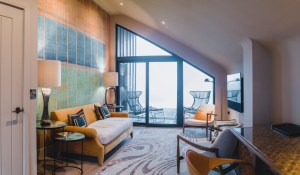
- For coastal interiors, adopt the policy of less is more with accessories. Something simple, such as a battered vintage map can tell a story.
- Vintage can often be your friend if you are working on a budget. There are so many ways to find preloved pieces and give them a new lease of life by painting or stripping off layers of lacquer.
- Go for the easy wins. Remove carpets for exposed floorboards, which can be painted or accessorised with jute or seagrass rugs.
- Remember where you are. Use local talent, materials, artist’s work etc to help your house feel connected.
- Dial down the glitz. Think natural textures for your coastal interiors, rather than silks or satins.
Stay in a stylish home
Styling your own coastal home just a dream? Get your fix by pretending you live in a beautiful one for a day or two at least.
You can stay in The Wishing Well, Selsey, or Trebrea Lodge, Tintagel, through boutique-retreats.co.uk

